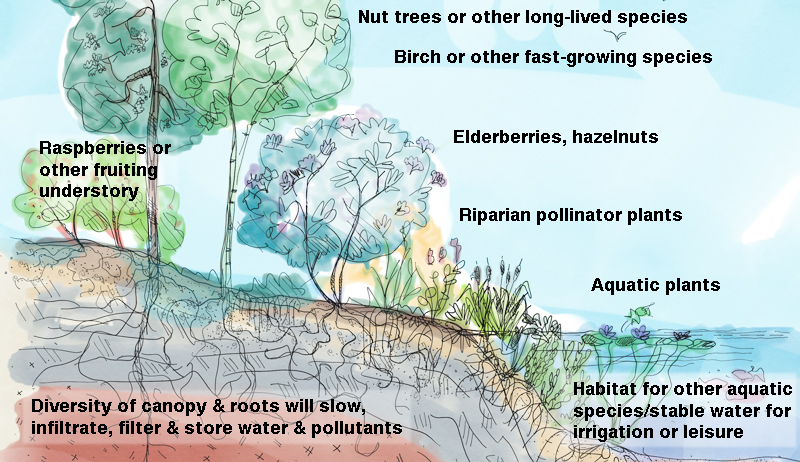
A riparian buffer can be a great addition to any farm. Riparian buffers enhance habitat, improve water resources and, potentially, add additional profit centers to a farm’s enterprises.
But what is a riparian buffer? Quite simply, it’s a planted strip of land adjacent to any water body or wet area on a farm.
Creating a riparian buffer can be as simple as allocating a 5-, 10-, 15- or 25-foot width of edge space around the farm stream or pond and leaving the grass to grow tall, un-mowed. Or you can seed into perennial grasses instead of plowing all the way to the edge.
You could also include a more layered and diversified planting that includes trees, shrubs and herbs.
Here’s how to use hügelkultur nursery beds for bare-root trees.
Riparian Buffer Benefits
A riparian buffer offers many benefits, which can vary depending on whether you’re using the land for crops, gardens or livestock.
Generally speaking, riparian buffers help to improve water resources by keeping them clean and by increasing their availability. If you have a wet area in a field, it is possible to excavate the area and create a groundwater-fed pond (or series of ponds) if it is spring-fed.
If there is a flowing stream or active pond, however, you can improve its structure and water quality, too.
Riparian buffers reduce erosion and siltation of stream and pond banks. This keeps the pond from filling in with silt, which reduces water-holding capacity and dirties the water.
Water quality is important for livestock, to prevent clogging of irrigation and, of course, for improved water resources downstream.
Riparian buffers can also prevent contaminants from entering the water—whether chemical toxins, manure runoff or both. The diversity of vegetation provides shade and reduces evaporative water loss. And roots hold the soil and improve groundwater flow into the reservoir.
Furthermore, riparian buffers can provide a new income source for the farm.
Put elderberries, hazelnuts and other valuable perennial crops near the water. You can plant fruit trees, berries and valuable timber species (like walnut and hickory) on the upland shoulders of the riparian area.
In this way, you can both improve water management on your farm and add new enterprises.
Riparian buffers always improve habitat for aquatic species, such as fish and waterfowl, as well as songbirds and amphibians—many of which may be endangered species.
For this reason, and other best management practices (such as water quality), you can often find available grants to help establish riparian buffers on farms.
Riparian Buffer Design
The best designs for riparian buffers are simple. I recommend a Permabed approach to riparian buffer design that utilizes the simple layout of slightly raised beds on contour with the wetland, stream or pond.
These can then be planted with different types of species based on their site-suitability.
You can place plants that like getting their feet wet on the downhill beds. Plants that prefer some drainage, conversely, can go in upland beds.
Organizing your planting for accessibility is also helpful. Alternate beds between those planted in trees and shrubs with others planted in grasses and herbs. This will allow you to move freely in your riparian buffer as you care for plants and trees.
Learn how to plant a tree the proper way.
Buffer Planting
When it comes time to plant, remember that you can use the same important garden techniques and tools.
Prepare a good planting site that is weed-free. Plant your trees at proper spacing for their future size. Alternate the size of the trees and shrubs in the bed so they share above- and below-ground space in a layered way.
Make sure to mulch the trees and use rodent guards over the winter in the early years. You have a water source, so a portable pump and sprinkler can help trees establish in drier periods or droughts.
And always take time to photograph and document your progress so you can refer back in the future to the great work you have done.
Grow On,
Zach




